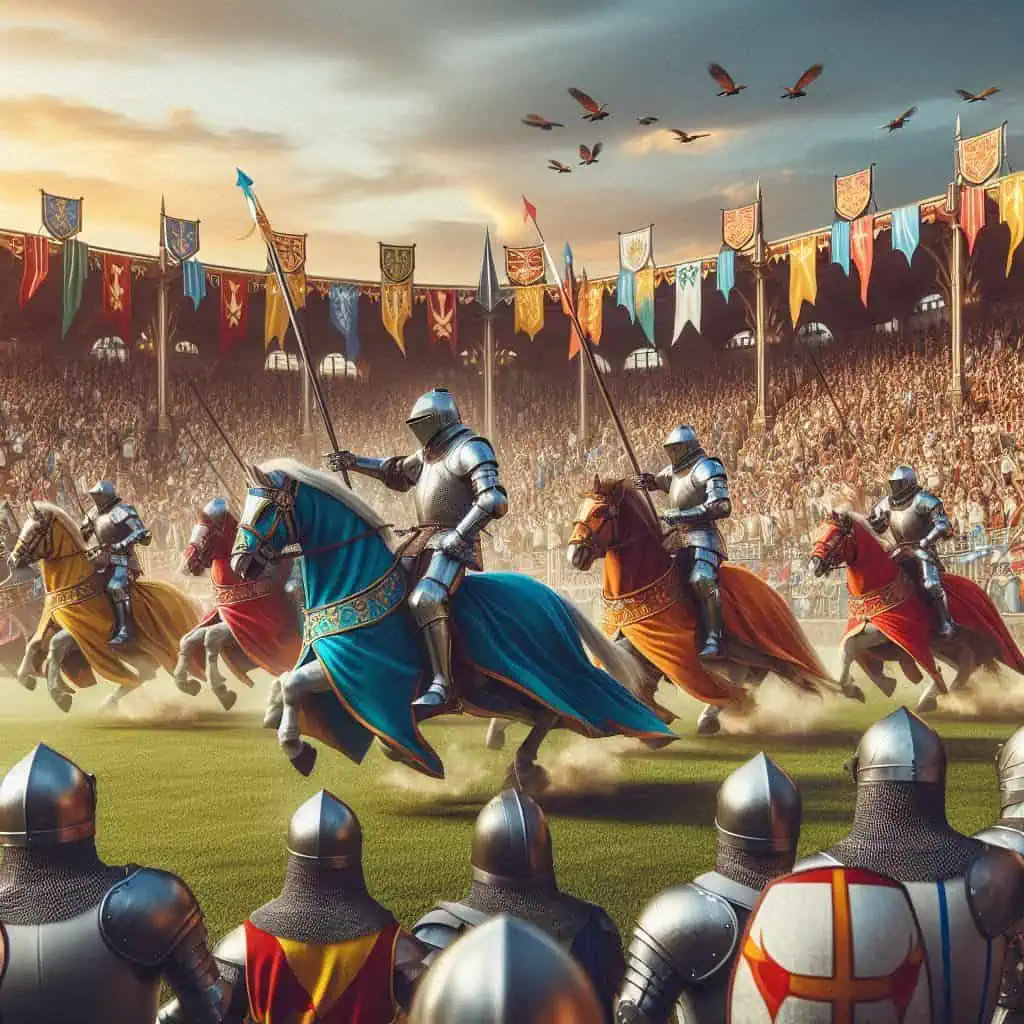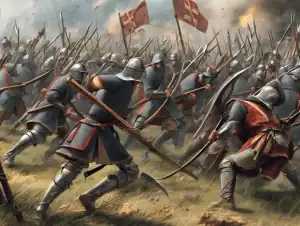The lance was a distinctive and iconic weapon closely associated with medieval knights, particularly during tournaments and cavalry charges. Long, sturdy, and often made of ash or pine, the lance was designed for use on horseback, allowing knights to deliver powerful thrusts while maintaining speed and momentum. It played a central role on the battlefield, where heavily armored cavalry units used it to break enemy lines with devastating force. Beyond warfare, the lance became a symbol of chivalry and knightly prestige, especially in jousting—a popular event in medieval tournaments where knights competed in controlled combat for honor and spectacle.
The word “lance” is derived from the Latin term lancea, which entered Old French as lance before being adopted into English. Its use, however, predates the medieval knight, with historical roots that trace back to ancient times, including strong links to Celtic warfare traditions. Over the centuries, the lance evolved in length, weight, and design—often fitted with vamplates or hand guards to protect the wielder during charges. Whether on the battlefield or in the lists, the lance remained a defining element of the knight’s arsenal throughout the medieval period.

What were Medieval Lances Made From?
Early medieval lances closely resembled spears, featuring long wooden shafts—typically made from ash or pine—and fitted with sharp metal heads designed for piercing enemy armor during cavalry charges. However, the lances used in medieval tournaments, or tourneys, were specially adapted for safety. These tournament lances were often made from hollow wood to reduce weight and impact, and they featured blunted tips such as the coronal—a multi-pronged head designed to spread the force of a blow and prevent serious injury.
Safety was a growing concern in jousting, especially as it became more ceremonial and less brutal over time. Innovations like the coronal head, along with other protective features such as lance rests and vamplates, helped reduce the risk of harm to knights during these competitive displays. In some cases, lightweight materials such as canes were even used in place of traditional lances, particularly in mock jousts or training events. These adaptations reflect the balance between pageantry and protection that defined medieval tournaments.

Disadvantages of Earlier Lances
Early medieval lances were not particularly effective against well-organized infantry formations, contrary to popular belief. Their full potential emerged later, around the 11th century, when cavalry began to adopt a more effective technique known as the couched position. In this method, knights tucked the lance under the arm, allowing the weight and momentum of the charging horse to drive the weapon forward with far greater force and accuracy.
This technique dramatically increased the impact of cavalry charges and became the standard in mounted warfare across medieval Europe. It was heavily influenced by tactics seen in the Middle East, particularly during the Crusades, where it was known as the “Syrian attack” due to its widespread use by Muslim cavalry forces. The adoption of this method marked a turning point in the use of the lance, transforming it into a devastating battlefield weapon rather than just a tool for skirmishing or display.

Later Medieval Lance Weapons
As the medieval period advanced, the design of the lance evolved significantly to meet the demands of changing warfare and tournament practices. Early medieval lances closely resembled spears, featuring relatively thin wooden shafts that offered limited durability and impact. However, by the late medieval period, lances had become much thicker, heavier, and sturdier—optimized for use by mounted knights during powerful cavalry charges.
These later lances often featured a shaped grip or handhold at the midpoint, making them easier to control and balance during high-speed attacks. Some were also equipped with a vamplate—a protective disc near the grip—to shield the knight’s hand from impact. Additionally, lanceheads were modified to prevent the weapon from penetrating too deeply into an opponent, reducing the risk of the lance becoming stuck or causing fatal injuries in tournaments. These refinements made the late medieval lance not only more effective in combat but also safer and more suited to the evolving code of chivalry.

Medieval Lances and the Knight
medieval lances along with the sword were the favorite weapons of the medieval knight, as a medieval knights armor developed to full plate lance rest were built into the design of his body armor, usually on the breastplate so that the medieval knight had easier control over the lance weapon, and not as much effort was used up when using the lance weapon.

Medieval knights would charge with the lance held across the horse with their lancehead sticking out to the left as they charged and they would meet at the center of the jousting track with an almighty clash of jousting sticks against shields or armor, quite often the Lance stick would snap on impact as they were designed to do this for tournaments.

The Decline of the Medieval Lance as a Weapon
As medieval weaponry evolved, so too did defensive technology—most notably with the development of full plate armor. This advanced armor significantly reduced the effectiveness of lances in warfare, as heavily armored knights became much harder to unseat or injure with a single charge. By the late medieval period, the introduction of gunpowder and firearms further diminished the role of traditional cavalry and their lances on the battlefield.
Despite their decline in military use, lances remained a central feature of jousting tournaments, where they continued to symbolize knightly skill and honor. These ceremonial competitions became more structured and stylized over time, preserving the use of the lance in a controlled, sporting context. Remarkably, the tradition of jousting with lances has endured, and modern reenactments and competitive jousting events still keep this iconic medieval weapon alive today.
What is a medieval lance?
A medieval lance was a long spear-like weapon used primarily by knights on horseback for charging and thrusting during battles and tournaments.
How was the medieval lance used in battle?
Knights used the lance to deliver powerful, high-speed thrusts from horseback, often to break enemy lines or unseat opponents during cavalry charges.
Where does the word “lance” come from?
The word “lance” comes from the Latin term lancea, which passed into Old French as lance before being adopted into English.
Did the design of the lance change over time?
Yes, the lance evolved in length, weight, and design over the medieval period, with features like vamplates (hand guards) added to protect the wielder during charges.
Was the lance only used in warfare?
No, beyond battlefield use, the lance was a symbol of chivalry and prestige, especially in jousting tournaments where knights competed for honor and spectacle.
How important was the lance to a knight’s arsenal?
The lance was a defining weapon of medieval knights, essential for both combat and tournament events throughout the medieval period.




